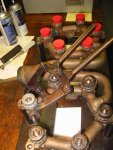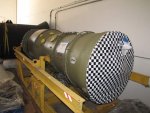Hey Beyond Biodiesle, lucky guy , love Sedona! , Its not really a need to re add additives , its a matter of adjusting the engine parameters to run with out them , to do that one needs a Jet Cal to trim the engine , along with the data to know what the Trim should look like, Its a matter of Outside air temperature, Barometric Pressure, Projected Turbine tempertures at known Power lever Angles in conjunction with Compressor inlet temperture and pressure not to mention combustion temps and pressure, So CIT, PLA,PB4, PB5, ITT, or TIT, depending on engine. PLA% and you hope your not dealing with a now very common variable vane geometry system, T5 is common on control systems and is the heart of the acceleration and rpm control. I cannot stress enough that the MAD MAX approach to turbine operation and maitainence is simply not possible, Disassembly of any jet engine takes training and skill along with a fair amount of special tooling that is not any where in the garage or for that matter readily available. Repair of most control subassemblies is impossible with out complex test gear , if at all, many components are only repaired at the manufacturer or depot level since the down sizing of the military, Harvesting "CANN" (cannibilized parts) will only get you so far even when you have a full shop available. Many of the seals and fragilble parts needed for reassembly are not available outside the military. Some thing as seemingly benign as a Thermocouple will likely be impposible to obtain and even then they are not universal between engine varients, and with out a jet cal one couldn't adjust it anyway.Modern jet engines ( turbo fan designations and on, ) are heavily computer controlled and there is simply no getting around that, and the nerd down the road isn't going to write new code to get around something, or repair it. It all ways looks neat to see the J 85 jet engine in a drag car at the track. But the idiots who run them and make no mistake they are playing with fire, Have no basis for trim values , no trackable excursion data ( times the engine is accelerated from power level to power level , how fast how hard, ) to base time change of industry known life limited components and most of all no containment for the compressor or turbine assemblies. Wait until they compressor stall the engine and shuck a turbine or send the fan right out the front, game over, and sadly for a large number of people in the stands. Biased YUP, done a lot of crash investigations ( aircraft crash) and ground mishap investigations, the only reason the military death rate is so low is redundant safety measures, almost stifling at times , but comprehensive. Don't laugh too loud, but the average Jet shop in the airforce mops floors more than the navy swabs the decks, FOD is deadly, and cleanliness is godliness in the Air Force Propulsion shops, By the way most have WHITE floors so one can see a 1/4 inch round washer less than 18 gauge from hundreds of feet laying flat. (used to superglue them to the floor and watch the Chief try to pick them up ) Water washing does nothing for coking in the fuel nozzles, It is used most heavily on A 10 a Wart hogs to remove gun gas from the compressor blades, The powder leaves a sticky residue that slows the blades and reduces Fan Speed to less than safe levels. It has NO cleasneing effect on the fuel nozzles at all . C 130s ( t56- 7 or 15 engines also water wash) aircraft flying at low level across sea water are washed to rinse corrosive salt residue, ( navy does the most of that ) Easiest way to clean a fuel nozzle is to simply change it, quick job for a good jet troop on most engines. Not trying to sound all mighty or discourage you, Just wanted to let you know how much more complex a turbine is than most people think, and some of the tiny turbines are much worse in complexity than the large turbo Jets





